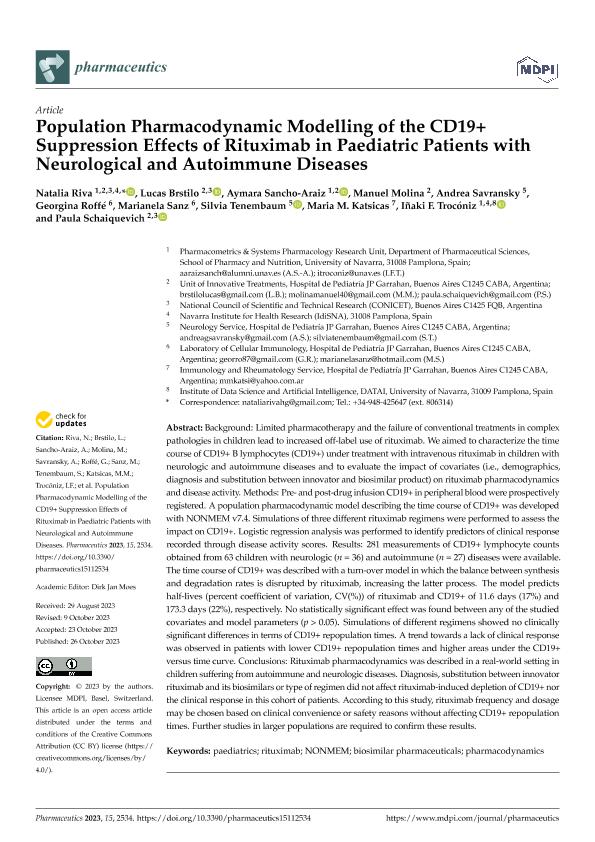Artículo
Population Pharmacodynamic Modelling of the CD19+ Suppression Effects of Rituximab in Paediatric Patients with Neurological and Autoimmune Diseases
Riva, Natalia ; Brstilo, Lucas Joel
; Brstilo, Lucas Joel ; Sancho Araiz, Aymara; Molina, Manuel; Savransky, Andrea; Roffé, Georgina; Sanz, Marianela; Tenembaum, Silvia; Katsicas, Maria M.; Trocóniz, Iñaki F.; Schaiquevich, Paula Susana
; Sancho Araiz, Aymara; Molina, Manuel; Savransky, Andrea; Roffé, Georgina; Sanz, Marianela; Tenembaum, Silvia; Katsicas, Maria M.; Trocóniz, Iñaki F.; Schaiquevich, Paula Susana
 ; Brstilo, Lucas Joel
; Brstilo, Lucas Joel ; Sancho Araiz, Aymara; Molina, Manuel; Savransky, Andrea; Roffé, Georgina; Sanz, Marianela; Tenembaum, Silvia; Katsicas, Maria M.; Trocóniz, Iñaki F.; Schaiquevich, Paula Susana
; Sancho Araiz, Aymara; Molina, Manuel; Savransky, Andrea; Roffé, Georgina; Sanz, Marianela; Tenembaum, Silvia; Katsicas, Maria M.; Trocóniz, Iñaki F.; Schaiquevich, Paula Susana
Fecha de publicación:
11/2023
Editorial:
MDPI
Revista:
Pharmaceutics
ISSN:
1999-4923
Idioma:
Inglés
Tipo de recurso:
Artículo publicado
Clasificación temática:
Resumen
Background: Limited pharmacotherapy and the failure of conventional treatments in complex pathologies in children lead to increased off-label use of rituximab. We aimed to characterize the time course of CD19+ B lymphocytes (CD19+) under treatment with intravenous rituximab in children with neurologic and autoimmune diseases and to evaluate the impact of covariates (i.e., demographics, diagnosis and substitution between innovator and biosimilar product) on rituximab pharmacodynamics and disease activity. Methods: Pre- and post-drug infusion CD19+ in peripheral blood were prospectively registered. A population pharmacodynamic model describing the time course of CD19+ was developed with NONMEM v7.4. Simulations of three different rituximab regimens were performed to assess the impact on CD19+. Logistic regression analysis was performed to identify predictors of clinical response recorded through disease activity scores. Results: 281 measurements of CD19+ lymphocyte counts obtained from 63 children with neurologic (n = 36) and autoimmune (n = 27) diseases were available. The time course of CD19+ was described with a turn-over model in which the balance between synthesis and degradation rates is disrupted by rituximab, increasing the latter process. The model predicts half-lives (percent coefficient of variation, CV(%)) of rituximab and CD19+ of 11.6 days (17%) and 173.3 days (22%), respectively. No statistically significant effect was found between any of the studied covariates and model parameters (p > 0.05). Simulations of different regimens showed no clinically significant differences in terms of CD19+ repopulation times. A trend towards a lack of clinical response was observed in patients with lower CD19+ repopulation times and higher areas under the CD19+ versus time curve. Conclusions: Rituximab pharmacodynamics was described in a real-world setting in children suffering from autoimmune and neurologic diseases. Diagnosis, substitution between innovator rituximab and its biosimilars or type of regimen did not affect rituximab-induced depletion of CD19+ nor the clinical response in this cohort of patients. According to this study, rituximab frequency and dosage may be chosen based on clinical convenience or safety reasons without affecting CD19+ repopulation times. Further studies in larger populations are required to confirm these results.
Palabras clave:
BIOSIMILAR PHARMACEUTICALS
,
NONMEM
,
PAEDIATRICS
,
PHARMACODYNAMICS
,
RITUXIMAB
Archivos asociados
Licencia
Identificadores
Colecciones
Articulos(SEDE CENTRAL)
Articulos de SEDE CENTRAL
Articulos de SEDE CENTRAL
Citación
Riva, Natalia; Brstilo, Lucas Joel; Sancho Araiz, Aymara; Molina, Manuel; Savransky, Andrea; et al.; Population Pharmacodynamic Modelling of the CD19+ Suppression Effects of Rituximab in Paediatric Patients with Neurological and Autoimmune Diseases; MDPI; Pharmaceutics; 15; 11; 11-2023; 1-15
Compartir
Altmétricas



